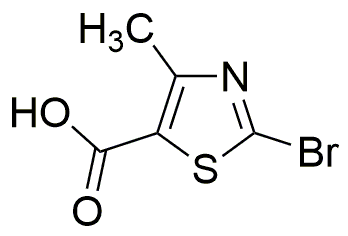2-Bromo-4-methylthiazole-5-carboxylic acid is widely utilized in research focused on:
- Pharmaceutical Development: This compound serves as a key intermediate in the synthesis of various pharmaceutical agents, particularly those targeting bacterial infections and other diseases. Its unique structure allows for the development of novel drugs with improved efficacy.
- Agricultural Chemicals: It is used in the formulation of agrochemicals, including fungicides and herbicides. The compound's effectiveness against specific pests makes it valuable for enhancing crop protection and yield.
- Biochemical Research: Researchers utilize this compound in studies related to enzyme inhibition and metabolic pathways. Its ability to interact with biological systems provides insights into cellular processes and potential therapeutic targets.
- Material Science: The compound is explored for its potential applications in creating advanced materials, such as polymers and coatings, that require specific chemical properties for durability and resistance.
- Analytical Chemistry: It serves as a reference standard in analytical labs for the detection and quantification of thiazole derivatives in various samples, ensuring accuracy in research and quality control.
General Information
Properties
Safety and Regulations
Applications
2-Bromo-4-methylthiazole-5-carboxylic acid is widely utilized in research focused on:
- Pharmaceutical Development: This compound serves as a key intermediate in the synthesis of various pharmaceutical agents, particularly those targeting bacterial infections and other diseases. Its unique structure allows for the development of novel drugs with improved efficacy.
- Agricultural Chemicals: It is used in the formulation of agrochemicals, including fungicides and herbicides. The compound's effectiveness against specific pests makes it valuable for enhancing crop protection and yield.
- Biochemical Research: Researchers utilize this compound in studies related to enzyme inhibition and metabolic pathways. Its ability to interact with biological systems provides insights into cellular processes and potential therapeutic targets.
- Material Science: The compound is explored for its potential applications in creating advanced materials, such as polymers and coatings, that require specific chemical properties for durability and resistance.
- Analytical Chemistry: It serves as a reference standard in analytical labs for the detection and quantification of thiazole derivatives in various samples, ensuring accuracy in research and quality control.
Documents
Safety Data Sheets (SDS)
The SDS provides comprehensive safety information on handling, storage, and disposal of the product.
Product Specification (PS)
The PS provides a comprehensive breakdown of the product’s properties, including chemical composition, physical state, purity, and storage requirements. It also details acceptable quality ranges and the product's intended applications.
Certificates of Analysis (COA)
Search for Certificates of Analysis (COA) by entering the products Lot Number. Lot and Batch Numbers can be found on a product’s label following the words ‘Lot’ or ‘Batch’.
*Catalog Number
*Lot Number
Certificates Of Origin (COO)
This COO confirms the country where the product was manufactured, and also details the materials and components used in it and whether it is derived from natural, synthetic, or other specific sources. This certificate may be required for customs, trade, and regulatory compliance.
*Catalog Number
*Lot Number
Safety Data Sheets (SDS)
The SDS provides comprehensive safety information on handling, storage, and disposal of the product.
DownloadProduct Specification (PS)
The PS provides a comprehensive breakdown of the product’s properties, including chemical composition, physical state, purity, and storage requirements. It also details acceptable quality ranges and the product's intended applications.
DownloadCertificates of Analysis (COA)
Search for Certificates of Analysis (COA) by entering the products Lot Number. Lot and Batch Numbers can be found on a product’s label following the words ‘Lot’ or ‘Batch’.
*Catalog Number
*Lot Number
Certificates Of Origin (COO)
This COO confirms the country where the product was manufactured, and also details the materials and components used in it and whether it is derived from natural, synthetic, or other specific sources. This certificate may be required for customs, trade, and regulatory compliance.


